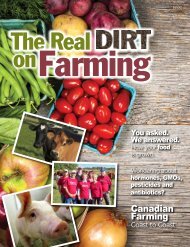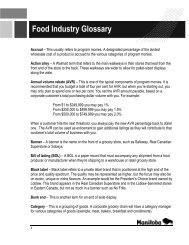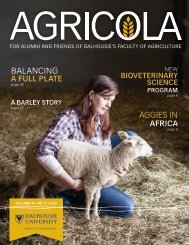SOYBEAN and BEES
BFhV4z
BFhV4z
You also want an ePaper? Increase the reach of your titles
YUMPU automatically turns print PDFs into web optimized ePapers that Google loves.
es from pod set to physiological maturity (R7) (Gazzoni <strong>and</strong> Minor, 1979; Gazzoni <strong>and</strong><br />
Moscardi, 1998).<br />
Nevertheless, insect attacking pods <strong>and</strong> seeds are far more noxious to the soybean plant than<br />
defoliators are. Their importance is limited to the R3-R7 soybean growth stages (Figures 2<br />
<strong>and</strong> 3). Their attack might result in loss of entire pods <strong>and</strong> seeds, or reduced seed weight.<br />
The recovery ability of soybean plant decreases as pods increase in size, or according the<br />
development of seeds (Fraser at al, 1982).<br />
The attack of stinkbugs to soybean seeds may lead to irreversible damage when attacking<br />
bugs affect the hypocotyl-radicle axis, which prevents the seed or affects seedling emergence<br />
(Corso, 1977).<br />
Sometimes, bug attacks can trigger physiological unbalance, <strong>and</strong> affected plants do not adequately<br />
complete its cycle, slowing the maturity process, causing leaf retention <strong>and</strong> troubling<br />
mechanical harvesting (Silva <strong>and</strong> Ruedell, 1983). Bugs are also responsible for disease<br />
transmission, since the location where mouthparts penetrate the seeds allows intrusion<br />
of pathogenic organisms in seeds, like the fungus Nematospora coryli <strong>and</strong> also species of bacteria.<br />
Besides yield reduction, severe attacks of stinkbugs result in reduced oil content <strong>and</strong><br />
increased grain protein content (Corso <strong>and</strong> Porto, 1978).<br />
It is important to mention that stinkbugs may colonize soybean plants in various stages of<br />
development. However, the ability to cause damage is restricted to its attack directly to pods<br />
<strong>and</strong> seeds, thus no noxious effects were observed prior to pod set <strong>and</strong> close to harvest. It is<br />
frequently observed even considerable populations of these insects prior to the blooming<br />
stage, increasing progressively in the reproductive phase, with an exponential growth, even<br />
accelerated at the end of the crop cycle, especially in the case of medium <strong>and</strong> late maturity<br />
cultivars, which remain longer in the field. This population increase is not only due to insects<br />
coming from eggs laid on the same field where they are observed. In most cases, population<br />
growth is due to the intense migration of adult insects from recently harvested crops, in<br />
search of better shelter, feeding <strong>and</strong> reproduction conditions.<br />
Soybean can st<strong>and</strong> a given level of stinkbug population without reducing its yield or seed quality.<br />
A pioneer <strong>and</strong> probably the most important <strong>and</strong> conclusive study on this area was conducted by<br />
Villas Boas et al. (1990), who studied for seven consecutive years the effects of different populations<br />
of bugs on soybean yield <strong>and</strong> seed quality. The authors found that on plots where the action<br />
level for controlling the pest were populations up to four bugs/m of soybean row, there was no<br />
statistical difference in the productivity <strong>and</strong> quality of seeds, as compared to plots with no stinkbugs<br />
(zero population). When the action level was set over four bugs/m, the yield consistently<br />
decreased, being also affected the seed viability <strong>and</strong> vigor.<br />
SoybeAn <strong>and</strong> bees<br />
19






